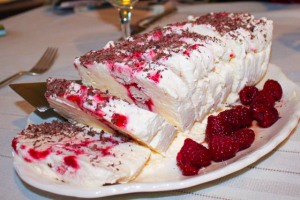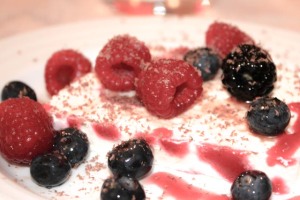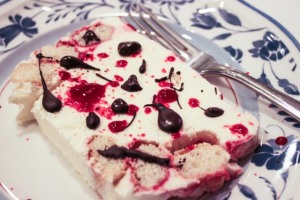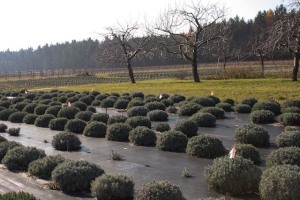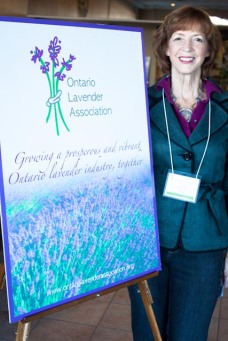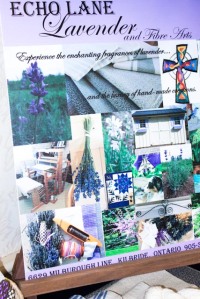______
When New Year’s Day rolls around, I celebrate with a feast. I believe “beginning with the end in mind,” one of Stephen Covie’s seven habits for highly effective people, is essential when planning a celebration dinner. That’s why I give special attention to dessert. To ring in 2013, I will serve an Italian frozen dessert, called semifreddo. This is Italian for “half cold.”
You may wonder how I discovered this frozen treat. Martha Stewart’s December issue of Everyday Food arrived and on the very last page, I spotted a recipe for “Lemon-Raspberry Semifreddo.” I frequently study Martha’s recipes to find opportunities to use lavender to enhance the flavor. My mouth watered as I imagined combining lemon, raspberries and lavender.
I’d never made a semifreddo, but when I read the recipe, I loved the simplicity. Not only easy to make, this dessert requires only 15 minutes of preparation. I also like anything that can be ready ahead of time and that gives me more time to visit with my guests. This dessert must hang out in the freezer for 8 hours or more, waiting off stage for its big moment.
I was curious about how semifreddo fits into the world of ice cream, gelato, custards and mousse. After consulting Harold McGee’s comprehensive book, “On Food and Cooking – The Science and Lore of the Kitchen,” I realized ice cream comes in various “styles.”
- Standard or Philadelphia-style ice creams made from cream and milk, sugar, and a few other minor ingredients.
- French or custard ice cream contains an additional ingredient, egg yolks, as many as 12 per quart/liter.
- Reduced-fat, low-fat, and non-fat ice creams contain progressively less than the 10% specified in the commercial definition of ice cream.
- Kulfi, the Indian version of ice cream that goes back to the 16th century, is made without stirring from milk boiled down to a fraction of its original volume, and therefore concentrated in texture-smoothing milk proteins and sugar. It has a strong cooked-milk, butterscotch flavor.
Semifreddo belongs to the custard ice cream style. However in this recipe, we skip the extra task of making custard because we use lemon curd in its place. Lemon curd contains lemon juice, sugar and eggs. If you want to make your own lemon curd, I recommend this recipe. Add lavender sugar to introduce lavender into your lemon curd.
I’m excited to have discovered semifreddo just in time for 2013. During this coming year, I will continue to experiment with new flavor combinations. What about a chocolate semifreddo with layers of crushed hazelnut biscotti and lavender flavoring for Valentine’s Day!
Wishing you a Happy New Year!
____________________________________
Lavender-Lemon-Raspberry Semifreddo
A luscious and creamy dessert reminds me of ice cream. The Italian word “semifreddo” means “half cold” and refers to a partially frozen dessert. – Serves 8
Ingredients
6 ounces of raspberries
2 tablespoons lavender sugar
2 cups heavy cream
1 cup lemon curd
10 ladyfingers
½ cup fresh berries soaked in 2 tablespoons of black berry liqueur
———————————————————————————————————-
1. Line a 4½ by 8½-inch loaf pan with 2 sheets of plastic wrap leaving a 3 inch overhang on long sides. In a blender, puree raspberries and lavender sugar scraping down sides to mix in sugar. Strain through a fine mesh sieve, pressing on solids: Discard solids.
2. In a large bowl, whip cream until soft peaks form. With a rubber spatula, fold in lemon curd. (You can make your own lemon curd or to keep it simple, you can buy high quality lemon curd at your grocery store. I used MacKays 100% Natural Fruit Lemon Curd.) Spoon 2 cups cream mixture into pan and smooth top.
3. Dip ladyfingers (I used Bouvard French Lady Fingers that I bought at my local grocery store.) in raspberry purée and arrange in pan, parallel to long edge. Pour remaining raspberry purée on ladyfingers. Top with remaining cream mixture and smooth top.
4. Wrap pan with overhanging plastic and freeze 8 hours (or up to 2 weeks). To serve, invert onto a serving platter, remove plastic and slice.
5. Garnish each slice with grated dark chocolate and fresh berries soaked in blackberry liqueur.
